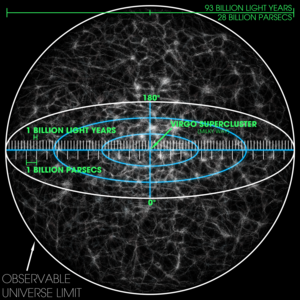Cosmic web

Visualization of the whole observable universe. The scale is such that the fine grains represent collections of large numbers of superclusters. The Virgo Supercluster – home of Milky Way – is marked at the center, but is too small to be seen.
|
|
| Diameter | 8.8×1023 km (28.5 Gpc or 93 Gly) |
|---|---|
| Volume | 4×1080 m3 |
| Mass (ordinary matter) | 1053 kg |
| Density | 9.9×10−30 g/cm3 (equivalent to 6 protons per cubic meter of space) |
| Age | 13.799±0.021 billion years |
| Average temperature | 2.72548 K |
| Contents |
Ordinary (baryonic) matter (4.9%) Dark matter (26.8%) Dark energy (68.3%) |
The observable universe is a spherical region of the Universe comprising all matter that can be observed from Earth at the present time, because light and other signals from these objects have had time to reach Earth since the beginning of the cosmological expansion. There are at least two trillion galaxies in the observable universe, containing more stars than all the grains of sand on planet Earth. Assuming the universe is isotropic, the distance to the edge of the observable universe is roughly the same in every direction. That is, the observable universe is a spherical volume (a ball) centered on the observer. Every location in the Universe has its own observable universe, which may or may not overlap with the one centered on Earth.
The word observable used in this sense does not depend on whether modern technology actually permits detection of radiation from an object in this region (or indeed on whether there is any radiation to detect). It simply indicates that it is possible in principle for light or other signals from the object to reach an observer on Earth. In practice, we can see light only from as far back as the time of photon decoupling in the recombination epoch. That is when particles were first able to emit photons that were not quickly re-absorbed by other particles. Before then, the Universe was filled with a plasma that was opaque to photons. The detection of gravitational waves indicates there is now a possibility of detecting non-light signals from before the recombination epoch.
The surface of last scattering is the collection of points in space at the exact distance that photons from the time of photon decoupling just reach us today. These are the photons we detect today as cosmic microwave background radiation (CMBR). However, with future technology, it may be possible to observe the still older relic neutrino background, or even more distant events via gravitational waves (which also should move at the speed of light). Sometimes astrophysicists distinguish between the visible universe, which includes only signals emitted since recombination – and the observable universe, which includes signals since the beginning of the cosmological expansion (the Big Bang in traditional physical cosmology, the end of the inflationary epoch in modern cosmology). According to calculations, the comoving distance (current proper distance) to particles from which the CMBR was emitted, which represent the radius of the visible universe, is about 14.0 billion parsecs (about 45.7 billion light years), while the comoving distance to the edge of the observable universe is about 14.3 billion parsecs (about 46.6 billion light years), about 2% larger.
...
Wikipedia
